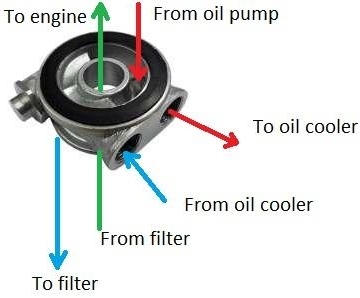The VW engine, both type 1 and type 4, have a so-called "internal cooler" that sits on top of the engine inside of the fan shroud. The flow of oil through that internal cooler is controlled by pressure valve in the bottom of the case. The temperature is controlled by oil pressure: When the oil is cold it is thicker so the valve by-passes the cooler, when it warms up and gets thinner and the oil pressure drops, the valve begins to route oil through the cooler and that's how it maintains a range of oil temp.
When the case is tapped for an external oil cooler, you tap right into the oil gallery as a return (you get the oil from the cover of the oil pump) so you've just by-passed the oil pressure valve. That means that all of the oil goes through the external cooler all of the time. Of course, this depends on exactly where the oil is gotten from and returned to, but you get the idea.
We get around the over-cooling problem by installing a thermo switch in the external oil line which by-passes the cooler under 180° and routes the oil through the cooler over 180°. It doesn't look like you have that oil switch on your car.
So we get back to one of your questions - was it running too cool and they eliminated the cooler? Possibly, but we don't know how much of the upright cooling system (fan shroud, engine tins, thermostat and air vanes inside of the shroud) you have in there. If you search on here about "cooling" you'll get an evening's worth of reading and know what I'm talking about - the engines in these cars are picky about having the proper engine tins installed. Also, that is a "bargain basement" cooler in there, because it doesn't have a powered fan to force air through the cooler. Not having a fan makes me wonder how well it might cool in the first place - probably not much. Most of us (a majority, for sure) are running either Setrab or DeRale coolers with 12v fans on them and they work well, especially if located in the left rear wheel well.
Bear in mind that the original type 4 engine had a "pancake" cooling system which was quite different from yours. While we've successfully adapted the Type 1 cooling system to the Type 4, cooling anything over 2 liters is always tougher to cool as it taxes the fan system a lot.
So......You could pull the cooler and get it tested to see if it is any good or just spring for a Setrab or DeRale 16-pass fan assisted cooler, and then install an external thermostatic Oil valve (someone will recommend one they like, I'm sure....Some of us run MoCal units) and you would be good to go. The other thing to make sure of is that ALL of the proper engine tins, heat shields, thermostat and air vanes are installed and working properly. All THAT would make it bullet-proof.



